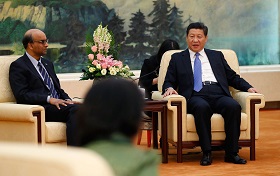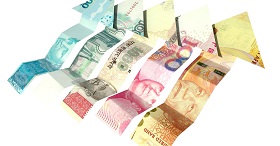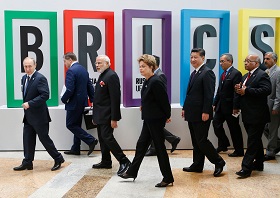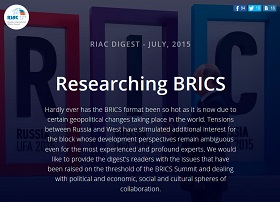BRICS New Development Bank: From Private to Public
New Development Bank of BRICS states opens
in Shanghai
(votes: 1, rating: 5) |
(1 vote) |
PhD in Economics, Senior Research Fellow at the Institute of Applied Economic Studies, Presidential Russian Academy of National Economy and Public Administration
The global economy has undergone significant transformations over the past few decades in connection with the changing role of developing countries and countries with rapidly growing economies. It is thanks to the contribution of these countries that the world economy was able to bounce back after the crisis of 2008—2009. What is more, many of the countries with rapidly developing economies have now accumulated substantial reserves in their national wealth funds, which they frequently invest in developed countries, thereby strangulating financing into the national economy. The BRICS New Development Bank, which was officially launched at the July 2015 BRICS Summit in Ufa, has been tasked with resolving these issues.
The global economy has undergone significant transformations over the past few decades in connection with the changing role of developing countries and countries with rapidly growing economies. It is thanks to the contribution of these countries that the world economy was able to bounce back after the crisis of 2008—2009. What is more, many of the countries with rapidly developing economies have now accumulated substantial reserves in their national wealth funds, which they frequently invest in developed countries, thereby strangulating financing into the national economy. The BRICS New Development Bank, which was officially launched at the July 2015 BRICS Summit in Ufa, has been tasked with resolving these issues.
New Resources or New Possibilities?
As was repeatedly stated in the run-up to, and immediately before, the BRICS Summit in Ufa, the main focus of the bank’s activities will be the financing of infrastructure projects. The issue of developing infrastructure is extremely important, not only for the BRICS countries, but also for other developing countries and countries with rapidly developing economies. For example, at the present time, one billion people around the world do not have access to all-weather roads; 783 million people do not have access to clean drinking water; and 1.3 billion people are without access to electricity.
The resource potential of the bank is limited to a starting capital of $50 billion and annual loans that do not exceed $3.4 billion. This is miniscule compared to the infrastructure loans offered by the World Bank.
It would be logical to assume that the main beneficiaries of the bank’s financing will be the founding countries themselves, as well as their priority partners. It is also important to note that individual infrastructure problems exist not only in these partner countries, but also in all of the BRICS countries.
Among the BRICS countries, India has the most infrastructural issues. Accordingly, the development of large-scale infrastructure projects is an absolute priority (Table 1).
Table 1.Infrastructure Development Level in BRICS countries and their Priority Partner countries (2010—2014)
| Russia | Priority Partners (average) 1 | Brazil | Priority Partners (average) 2 | China | Priority Partners (average) 3 | |
|---|---|---|---|---|---|---|
| Number of air transport registered carrier departures (2014) | 67440 | 22027 | 958782 | 59948,18 | 3,073,450 | – |
| Electricity consumption (kW per capita, 2010 – 2014) | 6486 | 2423 | 2438 | 961,28 | 3,298 | – |
| Fresh water consumption (billion m3, 2013) | 66,2 | 16,54 | 748 | 8,56 | 554,1 | – |
| Internet access (number of subscriptions per 100 people, 2013) | 16,62 | 9,94 | 10,08 | 6,9 | 13,63 | – |
| India | Priority Partners (average) 4 | South Africa | Priority Partners (average) 5 | |
|---|---|---|---|---|
| Number of air transport registered carrier departures (2014) | 681063 | 20771 | 185963 | 9556,7 |
| Electricity consumption (kW per capita, 2010 – 2014) | 684 | 54 | 4606 | 252,3 |
| Fresh water consumption (billion m3, 2013) | 761 | 15,83 | 12,5 | 4,23 |
| Internet access (number of subscriptions per 100 people, 2013) | 1,16 | 1,005 | 3,06 | 0,44 |
Source: Compiled by the author using World Bank data for 2015.
1 – CIS countries.
2 – Latin American countries and African countries with Portuguese as an official language.
3 – China is currently carrying out investment programmes, and provides development assistance to African, Asian and Latin American countries. China’s economic interests are the most diversified among the BRICS countries.
4 – Bhutan, Myanmar, Nepal, Afghanistan and a few African countries.
5 – Republic of Zimbabwe, Mali, Somalia.
The BRICS countries are positioning themselves as development partners, rather than donors.
Without a doubt, the BRICS partner countries that are the focus of the group’s south–south cooperation have much larger infrastructure problems. However, the resource potential of the bank is limited to a starting capital of $50 billion and annual loans that do not exceed $3.4 billion. This is miniscule compared to the infrastructure loans offered by the World Bank, which amounted to more than $65 billion in 2014.
Despite the fact that financing of the New Development Bank could reach $100 billion, the majority of the infrastructure needs in developing countries have still not been addressed. According to the World Bank, South Asian countries will require $2.5 trillion over the next ten years, while the BRICS countries will need $4.5 trillion over the next five years, in order to solve their infrastructure problems.
The establishment of the New Development Bank has nothing to do with creating fundamentally new mechanisms for cooperation. Nor does it contribute to the generation of sufficient resources to finance development programmes in the BRICS countries and those of its partners. A number of bilateral agreements on financing development programmes have already been reached between BRICS countries, including agreements on currency swaps (between China and Brazil) and bilateral loans (between China and South Africa).
Despite the fact that the BRICS countries are able to finance development programmes on a bilateral basis, a number of incentives encouraged them to set up the bank — firstly, the need to share risks, and secondly, the need to increase the legitimacy of their south—south cooperation [1].
The Combined Potential of the BRICS Countries
The Brazilian Development Bank (BNDES) provides support for Latin American and Caribbean countries; the development banks of China and India mainly work with their close neighbours in Asia; the Russian Federation concentrates its efforts on the CIS countries; and South Africa works with the Southern African Development Community.
Current practices of implementing economic development programmes, including International Development Assistance (IDA) programmes, as well as approaches to the activities of national development banks, served as a determining factor in the creation of the BRICS Development Bank.
The contribution of the BRICS countries to the development of the poorest countries is determined by the concept of “south—south development cooperation”, which presupposes expert and financial support with the aim of strengthening the economic and social situation in the South [2]. The BRICS countries are positioning themselves as development partners, rather than donors. This is why such cooperation also has a positive effect on trade, investment and other commercial operations for everyone involved.
It is difficult to estimate the amount of financing needed for IDA programmes because the majority of the BRICS countries do not have unified systems for calculating the resources to be allocated for the socioeconomic development of partner countries. According to expert estimates, China is the leading country in terms of financing IDA programmes (Table 2).
Table 2.The Amount of Aid Provided by BRICS Countries in 2008—2013 (million dollars in today’s prices)
| Country | 2008 | 2009 | 2010 | 2011 | 2012 | 2013 | Source |
|---|---|---|---|---|---|---|---|
| Brazil | 336,8 | 362,2 | – | – | – | – | Brazilian Cooperation Agency (ABC) |
| China | 1807,57 | 1947,65 | 2010,61 | 2841,4 | – | – | Fiscal Year Book, Ministry of Finance of the People’s Republic of China |
| India | 609,5 | 488,0 | 639,1 | 789,8 | – | – | Annual Reports, Ministry of External Affairs, Government of India |
| Russia | 220 | 789 | 472 | 514 | 465 | 609,6 | OECD Development Assistance Committee, Rossotrudnichestvo |
| South Africa | 89,2 | 119,5 | 98,4 | 160,5 | 151,9 | 156,7 | Estimates of National Expenditure, National Treasury of South Africa |
Source: OECD DAC. Statistics on Resource Flows to Developing Countries. Table 33a – Estimate of gross concessional flows for development co-operation (“ODA-like” flows) from the BRICS.

BRICS: Union of Reformers and National
Interests
Despite the difficulty of performing a quantitative assessment, a number of common IDA policies can be identified among the countries. Firstly, the economic interests of all BRICS countries include equal partner cooperation with neighbouring countries. Secondly, as a rule, grants and loans provided by the BRICS countries are not politically motivated. Thirdly, the assistance offered to certain countries often affects the commercial interests of businesses, ensuring their access to the national markets of their partner countries.
As for how the national development banks of the BRICS countries work, a great deal of their activity was originally targeted at financing infrastructure development projects. However, rising commodity prices in the early 2000s meant that the number of foreign economic transactions performed by these banks grew significantly, especially with their regional neighbours. Thus, the Brazilian Development Bank (BNDES) provides support for Latin American and Caribbean countries; the development banks of China and India mainly work with their close neighbours in Asia; the Russian Federation concentrates its efforts on the CIS countries; and South Africa works with the Southern African Development Community.
The financial component of the bank will include providing money for the public and private sectors. Financing will be provided on the basis of the effectiveness of the proposed projects.
A number of features that form the basis of the national development banks in the BRICS countries could complicate financial cooperation between the countries. The main problem here is the fact that the banks have different practices when it comes to assessing risk and approving loans. For example, the China Development Bank and BNDES have a very low share of problem loans in their credit portfolios. This is because these banks finance projects by large corporations, rather than those by small and medium-sized enterprises (SMEs), whose risks are significantly higher. In contrast to its partners, Russia’s Vnesheconombank (VEB) has a separate programme for financing SMEs. The Development Bank of Southern Africa (DBSA) was similarly exposed to high risks as a result of its lending to the most vulnerable sectors of the national economy during the 2008—2009 financial crisis.
Just where the banks got their money from is also of vital significance. VEB and BNDES, for example, attract long-term financing at low interest rates from pension funds, as well as through government bonds. The China Development Bank issues long-term bonds at low interest rates with state guarantees. The DBSA finances its projects by issuing bonds, as well as through loans from bilateral and multilateral development institutions, while the Export-Import Bank of India (EIBI) attracts funds by borrowing on the market.
Not only will the Memorandum of Understanding on Cooperation with the New Development Bank signed by the development banks of the BRICS countries be the institutional framework for this kind of cooperation, it will also help the overcome these differences and create a synergistic effect [3].
Mechanisms of the Bank’s Activities
In terms of guaranteeing operational efficiency, the work of the BRICS Bank should be as diversified as possible, and should include activities that are directly related to project/programme financing, as well as to the provision of consultancy services for partners and founding members.
The New Development Bank will complement, rather than replace, existing financial institutions in both the public and private sectors.
The financial component of the bank will include providing money for the public and private sectors in the form of loans by issuing guarantees, purchasing bonds, carrying out leasing transactions and forming part of charter capital. Financing will be provided on the basis of the effectiveness of the proposed projects. One of the projects that the Russian side intends to put up for consideration by the BRICS Bank is the high-speed Moscow–Kazan rail route.
Like other development banks, consultations can be provided both at the project proposal and implementation stages. At the same time, the bank should monitor and evaluate projects carried out with its participation. This will allow it not only to analyse the institution’s activities from a fiscal point of view, but also to assess the impact of such projects on the economic development of the region where the project or programme is being implemented.

Kazushige Kobayashi, Manuel A.J. Teehankee:
The AIIB’s Launch Sets the Stage for Supply-
Side Competition in Development Finance
It should be noted that this is by no means an exhaustive list of the bank’s activities. In the long term, the institution could grow in a similar way to that of other development banks — for example, the World Bank — and start to operate in new areas, such as insurance and arbitration services.
Parallel initiatives can also help to improve the bank’s work. For example, the Russian Direct Investment Fund (RDIF), China’s Silk Road fund, Brazil’s BTG Pactual, South Africa’s DMSA and India’s IDFC all signed an agreement at the BRICS Summit in Ufa on joint investment and infrastructure projects. It is expected that the funds will be used on a bilateral basis with a focus on investment projects and capital shares, rather than on debt financing. This will increase shareholders’ interest in projects exponentially.
Conclusions and Recommendations
The New Development Bank will undoubtedly complement, rather than replace, existing financial institutions in both the public and private sectors. In order to build and strengthen potential in this area, the founder countries could carry out work in the following areas.
Firstly, the ability of the bank to achieve its long-term objectives will depend on two variables — the reliability of financing and the amount of resources available. In practice, this condition can be fulfilled by attracting both public and private funding. Public resources will provide guarantees, accessibility, long-term stability and counter-cycle financing, while private resources can offer greater scope and diversification of loans.
Secondly, in the long term, the bank should extend its functions beyond simply providing infrastructure loans. It should become an institution of sustainable and “inclusive” development, supporting projects that promote economic growth and providing long-term loans for that very purpose. This would ensure the sustainability of the bank’s projects.
Thirdly, in order to get public support and international recognition, the decision-making process with regard to providing loans should be transparent. Doing this could lead to the establishment of internal and external monitoring and evaluation systems of the bank’s projects.
1. In 2010, the United Nations Conference on Trade and Development (UNCTAD) identified South—South Cooperation (SSC) as a set of processes, institutions and regulations designed to promote economic, political and technical cooperation between developing countries in order to achieve common development goals. UNCTAD, 2010. South-South Cooperation: Africa and New Forms of Development Partnerships. Geneva: UNCTAD, 2010.
2. Zimmerman Felix, Kimberly Smith. More Actors, More Money, More Ideas for International Development Cooperation // Journal of International Development, 23 (5), 2011, pp. 722–738.
3. Memorandum of Understanding on Cooperation with the New Development Bank between the Brazilian Development Bank (BNDES), State Corporation Bank of Development and Foreign Economic Activity (Vnesheconombank), Export-Import Bank of India, China Development Bank Corporation and the Development Bank of Southern Africa Limited. July 9, 2015.
(votes: 1, rating: 5) |
(1 vote) |







